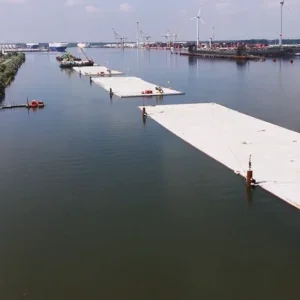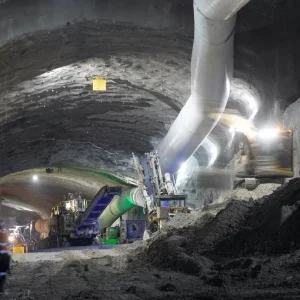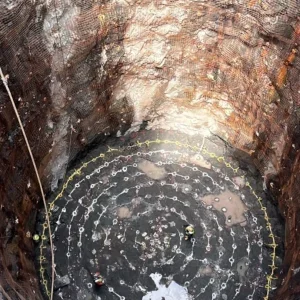Ventilation may not be the only aspect of tunnel design that must be reconsidered to prevent further tragic losses but it remains one of the most important elements, chiefly for the control of and access to incidents that have already occurred. The aspect of public protection dominates the thinking behind designs for traffic and rail tunnels. Consequently ventilation systems for tunnels under construction, or for access to non-public tunnels (sewers etc), adopt different technology, but which is no less important.
A growing problem, which has yet to be tackled fully, is the modification of ventilation in existing tunnels to meet modern standards and increased traffic loads. The French survey after the Mont Blanc tunnel fire, and subsequent Europe-wide survey of road tunnels, have shown that, in general, existing road tunnel systems are far from adequate. Whilst most metro authorities claim to have very safe systems, perhaps because the potential for danger is more apparent, the Kings Cross station fire showed that lessons still have to be learned. In this case the lessons were mainly about good housekeeping and rapid accelrator effects of forced air from train movements which act like a blast furnace fan.
The popular conception is that tunnel ventilation must feature safety at any cost, but in engineering terms cost must always be a factor. For example, jet fans in traffic tunnels for longitudinal ventilation are cheaper to install than larger fans requiring special ducting structures, but have previously been resisted in the US. However, following the Memorial Tunnel ventilation test programme and full-scale fire tests, this market is now starting to open up. Nevertheless, in many tunnels it is still necessary to have emergency extractor systems to remove smoke and fumes, or control ventilation zones for fire fighter access, etc.
In the fields of construction and maintenance, lives are still being lost due to entry into confined spaces in the presence of noxious gases or low oxygen levels. The main answers are not new — proper training, good house-keeping and efficient gas detectors.
There are special requirements in certain applications. For example Thames Water recently installed a gas detection upgrade on London Ring Main pumping shafts. The new system detects excess levels of chlorine and hydrogen sulphide used in water treatment, and protects against the possibility of fire.
Thankfully hazardous incidents due to poor ventilation during tunnel construction appear to be at a relatively low level, perhaps because workers and supervisors are aware of the potential dangers and have the right equipment and practices to tackle them.
To outline the ventilation technology currently available, here we list some recent product introductions and leading suppliers:
Detector upgrade
Crowcon has developed an upgrade package for its top-selling Triple Plus portable detector for multiple gas detection. The new Triple Plus+ specification has three instantaneous alarm levels and a rapid calibration feature.
The instrument can monitor up to fours gases simultaneously and can carry sensors for methane, oxygen and a range of toxic gases. Triple Plus+ also has an enhanced datalogging capacity allowing site and user names to be recorded together with an event logging facility to list every adjustment made by the users. Short- and long-term exposure levels to toxic gases can be calculated for periods of 15min and 8h respectively.
Confined space training
Dräger is now offering training specifically on gas detection equipment as well as its course on confined space and emergency procedures. Four course are included on gas detection with Dräger instruments, portable gas detectors and how to use them, recalibration and servicing of air monitoring equipment, and the use of gas detection equipment for confined space entry.
Courses can be held at Dräger’s European centre at Blyth, Northumberland or at customers’ own premises. Training concentrates on the correct choice of detection systems for each application, and the specific use of each instrument. The Dräger-tube range comprises 250 short-term tubes for around 430 different gases and vapours, whilst the Dräger microPac Single Gas Monitor is a pocket-size detector for carbon monoxide, oxygen and hydrogen sulphide.
Ducting
Amco Plastic manufactures PVC ventilation ducting both for exhaust and forced auxiliary systems, together with steel or grp cassette holder systems. The company has supplied recent tunnelling projects including Edmund Nuttall for the Portsmouth transfer tunnel, PT Tambang Baturba Bukit Asam in Indonesia, Colector General UTE, Alicante, Spain, Miller Civil Engineering for the Hull Flow transfer tunnel, and Dragados for various projects in Spain including the Madrid Metro.







